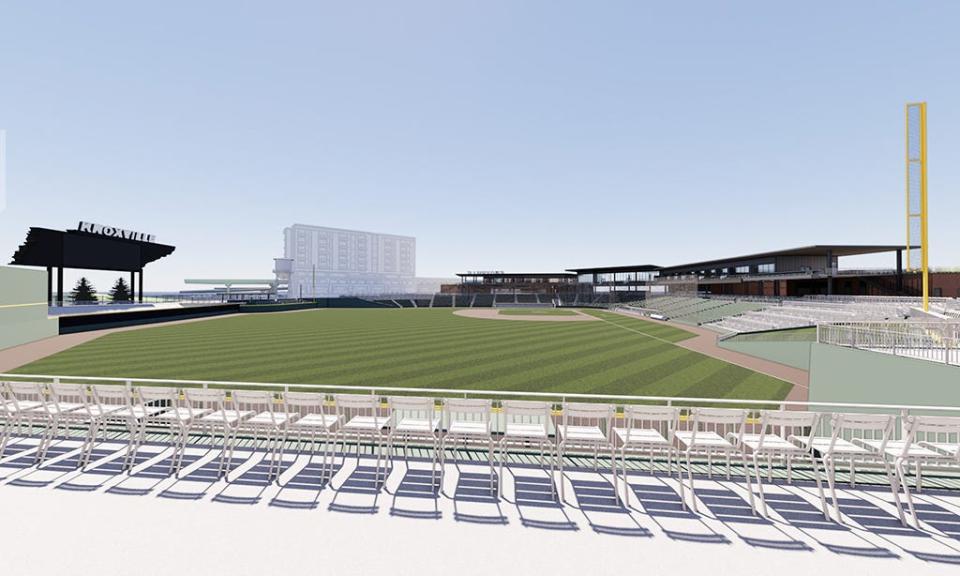Smokies stadium project sits on site of youthful memories | Opinion
I stood under the James White overpass on Willow Avenue on June 13 to watch the groundbreaking ceremony for the new Tennessee Smokies multi-use stadium. Before I got there I spent half an hour on the east side of the proposed facility at Willow and Florida Street. I sat in my car reminiscing about my days as a young boy playing and working on that site.
It had been 65 years since the area's first urban-renewal project had taken what little was there and did even less to replace it. My church, Tabernacle Baptist, sat in the middle of it, but it burned in 1951 and relocated to East Vine Avenue, which is now called Martin Luther King Jr. Avenue. The Shady Corner Grocery Store, where I helped stock the shelves as a seventh-grader, closed as the houses around it were removed.

I thought about the eight or 10 blocks I walked to Green School every morning during my two years of junior high school. I was reminded how I had to take a different route if FirstCreek had risen. I thought of the rickety bridge across that creek that could be scary to cross.I even thought of having to walk by the Camp Home at Jackson and Florida that served as the City Women's Prison. Those dirty old women offered frightened young boys various proposals.
All of those memories came from that depressed area of my youth that will soon be a part of some of the greatest prosperity in Knoxville history. As I watched those backhoes and dump trucks at work clearing the site, I envisioned the new hotels, restaurants, shops and other venues that will occupy the land once ravaged by the creek and owned or rented by some of the city's poorest people.
Hear more Tennessee voices: Get the weekly opinion newsletter for insightful and thought-provoking columns.
I imagined the sounds of the baseball bats, sports announcers and concert music that will replace the squealing of pigs at the slaughterhouse, and the aroma of popcorn that will replace the smells that permeated the air from the Union Stockyards. The beautification of the exposed section of the creek will replace the old swimming holes of "Glassy Bottom," "Sandy Bottom" and "Rocky Bottom." It can no longer rise from its banks and terrorize the neighborhood.
The high-priced cocktails in the fancy bars will overshadow the cost of the 50-cent drinks of splo, or moonshine, in the speakeasys of yesterday. As patrons sip from the micro beers on the rooftops, memories will fade of the days when Twenty Grand Ale, Red Top Ale, Champagne Velvet and Falstaf Beer were in vogue. The smells of frying fish and boiling ham hocks in the taverns will be replaced by fancy foods and snacks in more elegant settings.
Yet nothing can replace the taste of the hot tamales Andrew made at the corner of Patton and Campbell. Nor can we forget those ice cream treats sold from the pushcart of George, who made his daily rounds with different foods in the winter as well.
For the first 14 years of my life, my house sat one block east of the new stadium, and on the same block was the vacant field that hosted the tent shows of Silas Green and Mandy Green of New Orleans. We could get in free by helping erect the big tent, or just sneak under it when no one was looking. At Smithson or later Bill Meyer Stadium, we could watch a baseball game through the knotholes. That is not likely to happen at the new stadium.
One thing that will not change at the new Smokies stadium is the sound of a passing freight train that will run just one block away. In the early 1970s the trains stopped carrying passengers to the Southern Depot at Gay and Depot, but the humming of the diesels and the blowing of the whistles as they cross Randolph, Humes, Morgan and Central will remind us of yesterday.
Robert J. Booker is a freelance writer and former executive director of the Beck Cultural Exchange Center. He may be reached at 865-546-1576.
This article originally appeared on Knoxville News Sentinel: Opinion: Smokies stadium project sits on site of youthful memories

